Abstract
We consider a system of spins which have values ±1 and evolve according to a jump Markov process whose generator is the sum of two generators, one describing a spin-flipGlauber process, the other aKawasaki (stirring) evolution. It was proven elsewhere that if the Kawasaki dynamics is speeded up by a factor ε−2, then, in the limit ε → 0 (continuum limit), propagation of chaos holds and the local magnetization solves a reaction-diffusion equation. We choose the parameters of the Glauber interaction so that the potential of the reaction term in the reaction-diffusion equation is a double-well potential with quartic maximum at the origin. We assume further that for each ε the system is in a finite interval ofZ with ε−1 sites and periodic boundary conditions. We specify the initial measure as the product measure with 0 spin average, thus obtaining, in the continuum limit, a constant magnetic profile equal to 0, which is a stationary unstable solution to the reaction-diffusion equation. We prove that at times of the order ε−1/2 propagation of chaos does not hold any more and, in the limit as ε → 0, the state becomes a nontrivial superposition of Bernoulli measures with parameters corresponding to the minima of the reaction potential. The coefficients of such a superposition depend on time (on the scale ε−1/2) and at large times (on this scale) the coefficient of the term corresponding to the initial magnetization vanishes (transient bimodality). This differs from what was observed by De Masi, Presutti, and Vares, who considered a reaction potential with quadratic maximum and no bimodal effect was seen, as predicted by Broggi, Lugiato, and Colombo.
Similar content being viewed by others
References
F. Baras, G. Nicolis, M. Malek Mansour, and J. W. Turner,J. Stat. Phys. 32:1 (1983).
P. Billingsley,Convergence of Probability Measures (Wiley, New York, 1968).
G. Broggi, L. A. Lugiato, and A. Colombo,Phys. Rev. A 32:2803–2812 (1985).
M. Cassandro, A. Galves, E. Olivieri, and M. E. Vares,J. Stat. Phys. 35:603 (1984).
D. A. Dawson,J. Stat. Phys. 31:29 (1983).
G. F. Dell'Antonio, Small random perturbations and uniqueness of the limit measure for a vector field with a manifold of zeroes, CARR Preprint 6/88.
A. De Masi, P. A. Ferrari, and J. L. Lebowitz,Phys. Rev. Lett. 55:19, 1947 (1985).
A. De Masi, P. A. Ferrari, and J. L. Lebowitz,J. Stat. Phys. 44:589 (1985).
A. DeMasi, C. Kipnis, E. Presutti, and E. Saada, Microscopic structure at the shock in the asymmetric simple exclusion,Stochastics (1987), submitted.
A. DeMasi, E. Presutti, and E. Scacciatelli, The weakly asymmetric simple exclusion process,Ann. Inst. Henri Poincaré (1989).
A. De Masi, E. Presutti, and M. E. Vares,J. Stat. Phys. 44:645 (1986).
P. A. Ferrari, E. Presutti, E. Scacciatelli, and M. E. Vares, The symmetric simple exclusion process. I. Probability estimates, Preprint UCSB (October 1987).
R. L. Holley and D. W. Stroock,Kyoto Univ. Res. Inst. Math. Sci. Publ. A 14:86 (1978).
N. Ikeda and S. Watanabe,Stochastic Differential Equations and Diffusion Processes (North-Holland, 1981).
G. Jona-Lasinio and P. K. Mitter,Commun. Math. Phys. 101:409–436 (1985).
J. L. Lebowitz, E. Orlandi, and E. Presutti, Convergence of stochastic cellular automaton to Burgers' equation: Fluctuations and Stability,Physica D (1988).
J. L. Lebowitz, E. Presutti, and H. Spohn, Microscopic models of hydrodynamical behavior,J. Stat. Phys. 51:841 (1988).
T. M. Liggett,Interacting Particle Systems (Springer-Verlag, 1985).
C. W. Meyer, G. Ahlers, and D. S. Cannell,Phys. Rev. Lett. (1987).
D. W. Stroock and S. Varadhan,Multidimensional Diffusion Processes (Springer-Verlag, 1979).
W. D. Wick,J. Stat. Phys. 38:1005–1025 (1985).
Author information
Authors and Affiliations
Rights and permissions
About this article
Cite this article
Calderoni, P., Pellegrinotti, A., Presutti, E. et al. Transient bimodality in interacting particle systems. J Stat Phys 55, 523–577 (1989). https://doi.org/10.1007/BF01041597
Received:
Issue Date:
DOI: https://doi.org/10.1007/BF01041597



